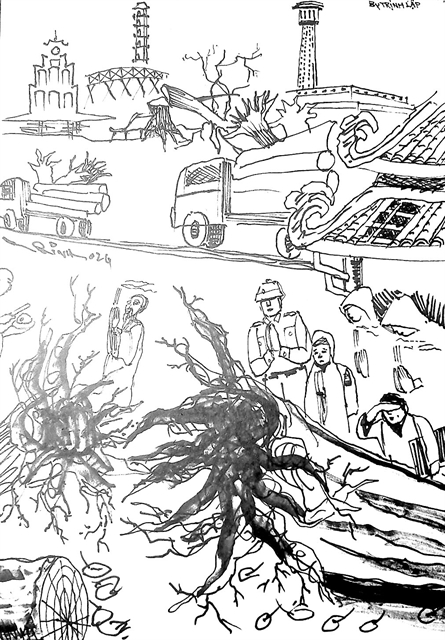 Talk Around Town
Talk Around Town

 |
| Illustration by Trịnh Lập |
by Nguyễn Mỹ Hà
Hanoians, like farmers with their crops, love their trees. The devastation caused by Superstorm Yagi showed just how much these trees mean to people—not only as beautiful landmarks but as icons for both residents and visitors, who often want to take photos beneath their branches.
“Oh my God, the sưa trees have fallen,” a friend of mine exclaimed as the storm hit Hà Nội on September 6. Her office overlooks the trees near Ba Đình Square, close to President Hồ Chí Minh Museum.
The sưa trees, or fragrant rosewood, are prized not only for their wood. In spring, their white blossoms brighten a corner of the square, attracting crowds eager to take photos beneath them.
But the storm took down more than just the precious trees.
The old banyan tree on Nhà Thờ Street, leading to St Joseph’s Cathedral, also fell. It not only provided shade in the summer but gave the area an ancient, nostalgic feel that both locals and tourists adored.
Phan Đình Phùng Boulevard, often called the most beautiful one in Hà Nội, also suffered losses. The boulevard, lined with three rows of century-old dragonplum trees, features Indochina villas and the relic of the Royal Thăng Long Citadel Gate. It is a symbol of Hà Nội’s historical charm, from ancient times to the colonial era.
Every summer, as students from a local high school of the same name prepare to say goodbye after 12 years of schooling, young women in white áo dài gather to take class photos here. This tradition has sparked a trend, with students from other schools flocking to the boulevard for their own pictures.
Just a few days ago, as the country celebrated Independence Day, women of all ages donned their most beautiful áo dài to pose beneath the dragonplum trees. The sunlight filtering through the leaves created magical moments, and so many people came to take photos that they had to wait in line.
In winter, the street's cosy sidewalk cafes, with views of the Citadel Gate, become popular rendezvous for young couples.
Now, as we pass the streets where many trees have fallen, we can see the open sky above.
The latest reports indicate that more than 23,000 trees were felled across inner Hà Nội and its neighbourhood districts. On September 9, the Hà Nội People's Committee [municipal administration] issued an order for rescue teams to cut branches and replant trees where possible.
Where 'landmark' trees have fallen, new ones of the same species will be planted.
In a show of solidarity, Hồ Chí Minh City has sent 48 experienced workers—20 to Hà Nội and 28 to Hải Phòng—to assist in clearing fallen trees.
Every year ahead of the storm season, the Hà Nội Trees Company prunes branches to help older trees withstand strong winds. But this time, the typhoon was too powerful, with wind speeds that no amount of preparation could have resisted.
These trees weren’t just decorations. They signalled your return home after a long journey, sheltered childhood games of hide-and-seek, provided shade in summer, and produced the oxygen we breathe.
Trees are the lungs of our planet, and these trees were Hà Nội’s lungs. They absorbed carbon dioxide and released oxygen. According to Environment Canada, a single tree produces an average of 260 pounds (118kg) of oxygen per year—enough for a family of four from just two mature trees.
With 23,000 trees lost, the oxygen they would have produced could have sustained nearly 50,000 people for a year.
Trees not only produce oxygen; they also act as natural air purifiers, filtering out pollutants and promoting public health. In urban areas, they reduce pollution and provide essential green spaces.
In Hà Nội, where concrete structures are rising daily, the rate of tree planting is struggling to keep pace.
Next summer, without the vast canopies of shade, those who work outdoors—such as xe ôm drivers, street vendors, and all of us who must travel for work—will feel the loss even more keenly.
On the internet, videos of the storm’s devastation have circulated widely. One clip stood out to me: amid the debris-strewn streets of Hà Nội, a tourist had just arrived, standing by the roadside when a passing motorbike rider shouted, “Welcome to Hà Nội!”
Yes, you’re welcome—to help make the city clean and green again. We can’t just wait for the trees to grow back on their own. Let’s each plant a tree now, I suggest. VNS




